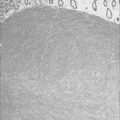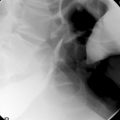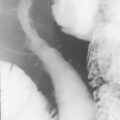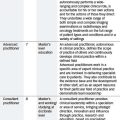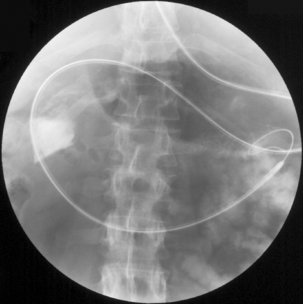CHAPTER 5 Symptoms of upper gastrointestinal disease
Introduction
Symptoms of the upper gastrointestinal tract are very common. The prevalence of upper gastrointestinal symptoms in Western populations is estimated to be 20–40%. The majority of people will have no clinically significant or benign causes. A small proportion (2%) will be caused by upper gastrointestinal cancers. It is estimated that approximately 3–4% of a general practitioner’s workload will consist of patients with upper gastrointestinal complaints but, on average, a single general practitioner will only see one patient with esophageal cancer in 5 years, one gastric cancer in 3 years and one pancreatic cancer in 4 years. It is therefore important to maximize the yield of investigations by identifying those patients who are more likely to have pathology. In 2002, guidelines were issued by The British Society of Gastroenterology with this aim. In this chapter, we will discuss commonly encountered symptomatology and investigations.
Dyspepsia
Dyspepsia is a general term used to refer to upper abdominal (including retrosternal) pain. This is a general non-specific term and is sometimes interchanged with indigestion. Dyspepsia is very common and is estimated to affect some 25% of the population. Using dyspepsia in its broadest sense, its cause may be functional, ulcer, gastroesophageal reflux disease, gallstones and cancer. Functional refers to failure to function normally related to either the muscles of the organ or the nerves that control the organ. The symptoms of dyspepsia are varied and, in 2006, an updated symptom criteria was proposed further to define this. The Rome III committee was published and the definition of dyspepsia was again refined (Tack et al., 2006). They have defined functional dyspepsia as symptoms originating in the gastroduodenal region in the absence of any organic, systemic or metabolic disease that is likely to explain these symptoms. This is further refined into two new symptom classes: epigastric pain syndrome, referring to epigastric pain/burning and postprandial distress syndrome, which is meal-induced symptoms.
The Rome III criteria are, in reality, of little use to clinicians in everyday practice. The management of such a patient has been rationalized by the National Institute of Clinical Excellence (NICE). Briefly, the initial management should focus upon excluding causes of dyspepsia from medications, excluding alarm symptoms and Helicobacter pylori (H. pylori) infection. A short course of proton pump inhibitor may be prescribed and the effect monitored. Persistence of symptoms or appearance of alarm symptoms will require urgent endoscopic investigation (British Society of Gastroenterology, 2004).
Gastro-esophageal reflux disease (GERD)
This condition is caused by stomach contents refluxing into the esophagus. The most common refluxate is gastric acid and sometimes bile may also be the refluxing agent. Reflux occurs infrequently in many people and usually does not cause major harm or concerns as the refluxate returns to the stomach rapidly. Esophagitis and symptoms of retrosternal pain occur when there is persistent acid or bile reflux in the esophagus (Weatherall et al., 1996).
Treatment of GERD includes lifestyle modifications (stop smoking, reduce alcohol intake, refrain from spicy foods, caffeine and weight reduction in those who are overweight). If conservative therapy fails then anti-reflux surgery is indicated (see common gastrointestinal surgery).
Alarm (RED flag) symptoms
The British Society of Gastroenterology (2005) published guidelines for referral for suspected upper gastrointestinal cancers. In that, they listed:
Chronic gastrointestinal bleeding may result from the upper and lower gastrointestinal tract (see Chapter 10). Chronic gastrointestinal tract bleeding may result in normocytic or microcytic anemia. Patients who have upper gastrointestinal bleeding may complain of black offensive smelling stool (melena). Iron deficient anemia is commonly found. It has been estimated that gastrointestinal cancers are found in approximately 10% of patients presenting with iron deficient anemia and approximately 4% are from the upper gastrointestinal tract (James et al., 2005; Killip et al., 2007). Unintentional weight loss is defined as decrease of 5% or more in body weight within a 6–12 month period. It may be caused by organic, psychosocial and unknown etiologies. Of these, approximately 25% are caused by malignancies (Lankisch et al., 2001; Metalidis et al., 2008). Weight loss in gastrointestinal malignancy may be caused by reduced nutrient intake caused by physical obstruction of food intake (dysphagia and vomiting), anorexia, early satiety and other tumor hormonal factors.
Dysphagia is difficulty in swallowing and may be further refined to impedance in swallowing solids and liquid (see Chapter 7). Though it may be difficult, dysphagia should be distinguished from globus sensation, which is a feeling of having a lump in the throat, which is unrelated to swallowing and occurs without impaired transport.
Vomiting may occur in complete or severe dysphagia and in gastric outlet obstructions. Gastric outlet obstruction may be caused by functional (e.g. diabetic gastroparesis) or mechanical (gastric cancers and peptic ulceration) conditions. Early satiety and fullness are common in gastric and head of pancreas cancers. About 50–60% of gastric outlet obstruction is caused by malignancy with 50% of these from pancreatic cancers (Kaw et al., 2003). Patients may complain of a mass in the epigastrium from a distended stomach or from the cancer itself.
Diarrhea
Diarrhea is defined as frequent passage of watery stools. Diarrhea may be acute or chronic (lasting more than 2 weeks) (Table 5.1). Nausea, vomiting, anorexia, weight loss, passing blood per rectum, dehydration, abdominal pain and fever may also accompany diarrhea.
| Causes | Investigations |
|---|---|
Infectious diarrhea: the most common cause of diarrhea is infective which may be bacterial (salmonella, staphylococci, Escherichia coli, Clostridium difficile), viral (Norovirus, rotavirus, Norwalk virus, cytomegalovirus) and less common in developed countries, parasites (Giardia lamblia, Entamoeba histolytica and Cryptosporidium). The majority of diarrhea is self-containing and resolves after a few days.
The value of stool culture is limited. A large study of 59,500 specimens only yielded a positive result in 6.4% of cases. A timely stool culture is crucial to confirming or excluding infective causes (<3 days infective, <4 days parasitic from onset) (Valenstein et al., 1996).
Celiac disease is a common condition, affecting about 1 in 100–300 adults in the UK, that is caused by intolerance to gluten. Anti-endomysial, anti-gliadin and anti-tissue transglutaminase antibodies as well as IgG and IgA levels are used for detecting celiac disease before gastroscopy to obtain tissue biopsy for confirmation which remains as the gold standard for confirming celiac disease. Radiological studies (abdominal CT, small bowel enema) for celiac disease are used for detecting complications of the disease (intussusception (usually intermittent), ulcerative jejunitis, osteomalacia, cavitating lymph node syndrome and an increased risk of malignancies such as lymphoma, adenocarcinoma and squamous cell carcinoma) rather than as a diagnostic tool (Buckley et al., 2007).
Lactose intolerance is the inability of the body to digest lactose, which is a sugar commonly found in milk and diary products. A degree of lactose intolerance is found in approximately 75% of the population. Hydrogen breath test, lactose/milk intolerance test, small bowel biopsy and stool acidity tests are used to detect lactose intolerance. Radiology does not have much role in managing this condition.
Inflammatory bowel disease: Crohn’s and ulcerative colitis are discussed in Chapter 16. Investigations include gastroscopy, colonoscopy, enteroscopy, small bowel enema and abdominal CT scan.
Investigations for dumping syndrome include gastroscopy and barium swallow and follow through.
Nausea and vomiting
Nausea and vomiting are symptoms that can accompany many conditions (Table 5.2). It is important to take a detailed medical history that will help direct the investigations. In general, vomitus that does not contain bile is likely to be but not always of less serious nature (central causes). Vomitus that contains bile is taken to be more significant and may suggest an obstruction somewhere beyond the second part of the duodenum (bowel obstruction, pancreatic cancer).
| Causes | Investigations |
|---|---|
British Society of Gastroenterology. Dyspepsia: managing dyspepsia in adults in primary care. 2004 http://www.nice.org.uk/Guidance/CG17.
British Society of Gastroenterology. Referral for suspected cancer. A clinical practice guideline. 2005. June
Buckley, Brien J., Ward E., et al. The imaging of coeliac disease and its complications. Eur. J. Radiol.. 2007;65(3):483-490.
James M.W., Chen C.M., Goddard W.P., et al. Risk factors for gastrointestinal malignancy in patients with iron-deficiency anaemia. Eur. J. Gastroenterol. Hepatol.. 2005;17(11):1197-1203.
Kaw M., Singh S., Gagneja H., et al. Role of self-expandable metal stents in the palliation of malignant duodenal obstruction. Surg. Endosc.. 2003;17(4):646-650.
Killip S., Bennett J., Mara D., et al. Iron deficiency anemia. Am. Fam. Physician. 2007;1:671-682.
Lankisch P., Gerzmann M., Gerzmann J.F., et al. Unintentional weight loss: diagnosis and prognosis. The first prospective follow-up study from a secondary referral centre. J. Intern. Med.. 2001;249(1):41-46.
Metalidis D., Knockaert H., Bobbaers S., et al. Involuntary weight loss. Does a negative baseline evaluation provide adequate reassurance? Eur. J. Intern. Med. 2008;19(5):345-349.
Tack J., Talley N.J., Camilleri M., et al. Functional gastroduodenal disorders. Gastroenterology. 2006;130:1466-1479.
Valenstein P., Pfaller M., Yungbluth M. The use and abuse of routine stool microbiology: a College of American Pathologists Q-probes study of 601 institutions. Arch. Path. Lab. Med. 1996;120:206-211.
Weatherall D.J., Ledingham J.G.G., Warrell D.A., editors. Diseases of the oesophagus. Oxford: Oxford Textbook of Medicine, 1996.


